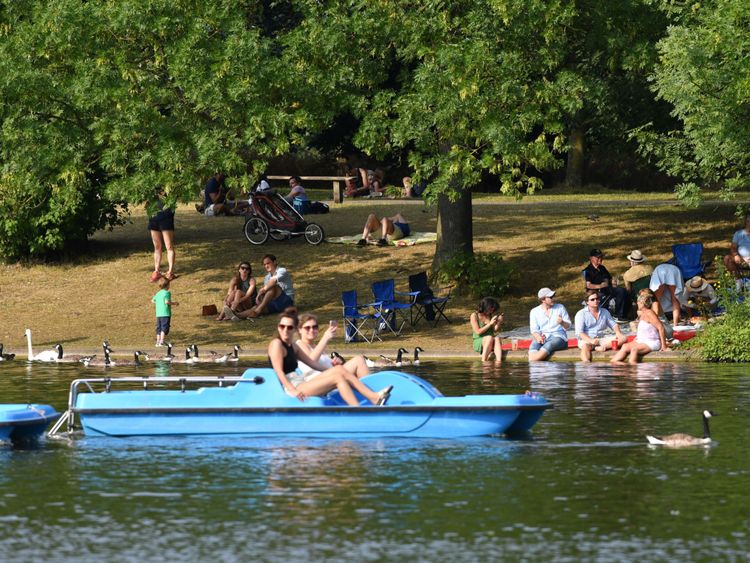The UK is set to bask in sun for a further four weeks as concern grows over water shortages.
Weather forecasters are expecting very little rain and high temperatures throughout the month, following a dry June.
A high-pressure system over the UK will maintain temperatures in the high 20s, with computer models suggesting there will be no widespread rain through the first half of July.
The warm period may, however, struggle to beat the drought of 1976 where there was a record 45 days without rain, Sky weather presenter Isobel Lang said.
With higher-than-average temperatures there is concern over water levels in rivers and reservoirs.
Hosepipe bans have already been in place in some areas during June and these are likely to spread to other parts of the UK.
Northern Ireland issued its first hosepipe ban in 23 years on Friday as NI Water said it could not treat water quickly enough to satisfy increased demand.
Southern Water asked customers on Thursday to spend no longer than four minutes in the shower and to use rainwater to water plants.
Severn Trent Water in the Midlands and United Utilities in the North West asked people to not use hosepipes and sprinklers.
Crisp, broccoli and lettuce producers are warning of a shortage due to the prolonged period of cold weather at the start of the year followed by high temperatures and a lack of rain.
The South West experienced some relief on Sunday with heavy downpours after the Met Office issued its first thunderstorm warning.
However, those regional showers are expected to be followed by more dry, sunny weather and temperatures in the mid-20Cs.
Tennis lovers will be in for a warm Wimbledon. The tournament starts today, with centre court’s retractable roof unlikely to be used due to rain – though it could be closed for sun protection.
The All England Club has assured players concerned about the state of the grass courts they will be able to irrigate them every evening because of the nice weather.
Wimbledon Park, where fans began camping for tickets over the weekend, reached 30.4C on Sunday afternoon.
The glorious weather has also meant the UK’s most endangered butterfly has made a bumper early appearance.
Early counts at Heddon Valley in North Devon have revealed there are more than 200 high brown fritillary butterflies.
However, the dry conditions mean firefighters battling moorland fires in Lancashire and Greater Manchester face further difficulties.
A major incident was declared on Saturday at Winter Hill near Bolton in Lancashire after two large fires merged due to increasing wind speed.
Fire brigades from across the country are helping battle the fire and another near Stalybridge in Tameside, Greater Manchester, which started on 24 June.
Forecasters say there is potential for showers in the North West “but it could be a one-off, isolated and unlikely to hit the area”, Met Office forecaster Helen Roberts said.
On Sunday night Tony Crook, group manager at Lancashire Fire and Rescue Service, told Sky News arsonists have been spotted from a police helicopter lighting new fires near Winter Hill.
Lancashire Police said it has had to deal with “reckless and dangerous” behaviour by people determined to get photos of the fire on their phones blocking access roads for emergency vehicles.
Others have been flying drones over the moorland, hampering efforts to douse the fires by helicopter.
From – SkyNews


